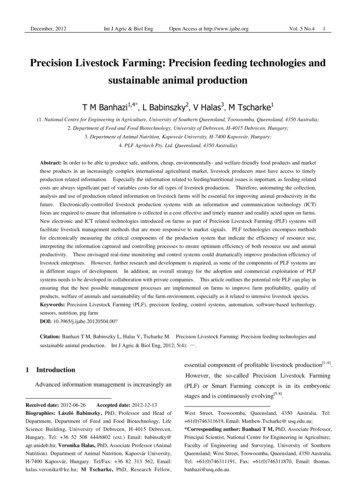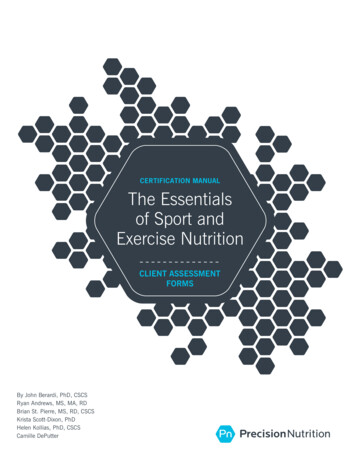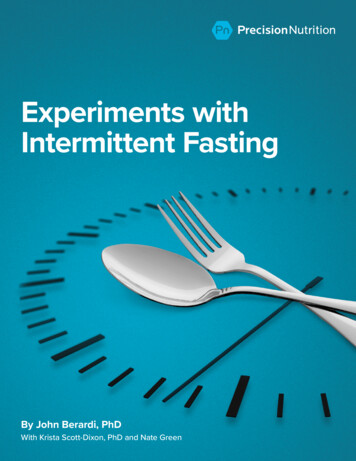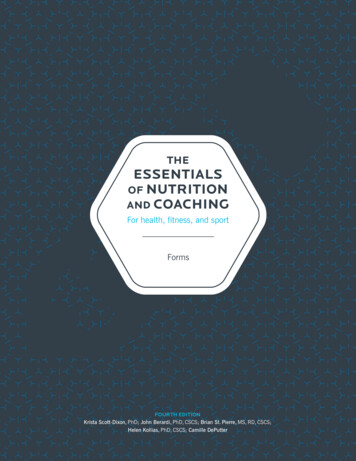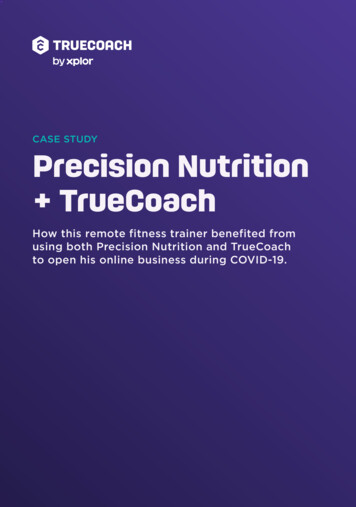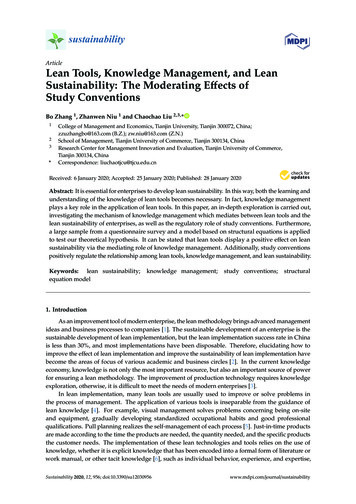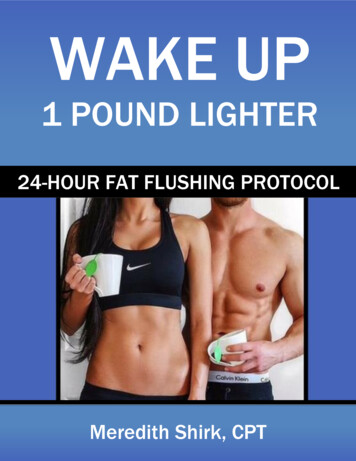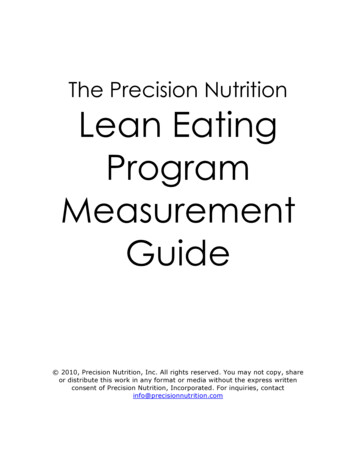
Transcription
The Precision NutritionLean EatingProgramMeasurementGuide 2010, Precision Nutrition, Inc. All rights reserved. You may not copy, shareor distribute this work in any format or media without the express writtenconsent of Precision Nutrition, Incorporated. For inquiries, contactinfo@precisionnutrition.com
Table of contentsIntroduction . 1Part 1: Body weight measurement . 2Step 1: Find a scale. . 2Step 2: Test & calibrate. . 2Step 3: Test again. . 2Step 4: Weigh yourself. 2Step 5: Record. 3Step 6: Repeat measurement under similar conditions. . 3Summary. 3Part 2: Body fat measurement. 4Find a trained professional . 4Measurement steps. 4Step 1: Buy calipers. . 5Step 2: Find a buddy. 5Step 3: Practice. 5Step 4: Measure three times and average the values. . 5Step 5: Record your results. . 5Step 6: Standardize your measurements. 5Summary. 5Part 3: The skinfold sites . 6Measurement technique . 6Site 1: The abdominal site. 7Site 2: The triceps site . 8Site 3: The chest site . 9Site 4: The midaxillary site .10Site 5: The subscapular site.11Site 6: The suprailiac site .12Site 7: The thigh site .13Part 4: The skinfold equations .14Part 5: Girth measurements.15Step 1: Pick up a good measuring tape. .15Step 3: Wrap tape around body part. .19Step 4: Tighten tape to a snug fit.19Step 5: Read measurement. .19Step 6: Record.20Part 6: Photographs .21Appendix A: Skinfold Measurement Worksheet.23Appendix B: Girth Measurement Worksheet.24Appendix C: Results Tracker Worksheet.25
Measurement Guide1IntroductionAt Precision Nutrition, we know through experience that you need to measure thingsto see if your exercise, nutrition and supplement plan is working for you. Withoutmeasurement, we can’t see improvement. And what’s the point of all this effort ifnot to improve something?Thus regular assessment is important. We record a number of our clients’measurements every week and others every few months.For example, we make sure that clients report body weight and girth measuresweekly. Every month, clients take progress photographs. And every three months,Lean Eaters report on their skinfold bodyfat measurements.In this guide you’ll learn about what measures we use and how often we use them.In the beginning, you may have to take more time and make more measurements.You’ll eventually determine which tests are best for your goals (these will changeover time and perhaps so will the tests). Like anything else in life, you’ll becomevery efficient at doing them.If you consistently follow the nutrition and training advice in the Lean Eatingprogram, you should see and feel real results. You can expect to make a few tweaksto perfect and individualize your plan. Yet the only way to know when and whattweaks are necessary is to take regular measurements and let the results guideyour program decisions.
2Measurement GuidePart 1: Body weight measurementMeasuring body weight is the most common way people assess changes in theirbody, especially when they’re hoping to see changes resulting from proper eating andexercise. Unfortunately, however, body weight measurements can be misleading.Compare two people:One person loses 20 lbs of fat and gains 20 lbs of lean mass from a newtraining and nutrition program. Their body weight doesn’t change, but theirbody composition shifts dramatically, and they look significantly different (inother words, better).A second person loses 20 lbs, but all of that weight loss is lean mass. Theylost weight, but they probably look worse.As you can see, “scale weight” doesn’t tell you much about your body composition.Don’t use body weight alone to help you with decisions about exercise and nutrition.But scale weight isn’t useless. You simply have to interpret it correctly, incombination with body composition. So let’s start with body weight; we’ll discuss bodycomposition later.Follow these steps to measure your body weight accurately and reliably:Step 1: Find a scale.Start with a good scale, preferably a pre-calibrated digital scale or a beam scale (likethe kind you find in doctor’s offices).Step 2: Test & calibrate.Once you have a good scale, determine its accuracy and reliability. To do so, selectan object of known weight (in the lab we use a pre-calibrated reference weight) andweigh it 5 times successively. If these 5 readings are within one pound or so of boththe known weight of the object and the other readings, your scale is as good asyou’re going to find. If the variation is greater than 2 lbs, you’ll need to re-set yourscale (if it’s digital). If it still doesn’t produce reliable or accurate readings, you need abetter scale.Step 3: Test again.Each time you weigh yourself, make sure to test your known object a few times (3times or so) beforehand to see if the scale is accurate and reliable on that day. Thesame rules above apply.Step 4: Weigh yourself.Next, step on the scale yourself. Record your first reading. Weigh yourself 2 additionaltimes and record these readings. If your measurements are within 1 lb of each other,take the average of the three. If not, weigh a fourth time and average the closestthree measurements.
Measurement Guide3Step 5: Record.Record the mean (average) body weight measurement in the online Weekly ProgressUpdate form. If you would like to keep a written record (not a bad idea!) then you canuse the Results Tracker worksheet in the Appendix.Step 6: Repeat measurement under similar conditions.Weigh yourself at the same time of day (i.e. morning, afternoon, or evening) and atthe same time relative to your meals. After all, your weight could fluctuate by 5 lbs ormore after a particularly large meal. If you regularly weigh yourself in the morningbefore eating, continue to do so. Or if you regularly weigh yourself after breakfast,continue to do so.Note: The process above is a deliberate one and is designed for maximal accuracyand reliability. However, once you’ve determined the accuracy/reliability of your scaleyou may not need to go through all the repeated measures. After all, I know mypersonal scale is good. When I want to take a measurement I step right on it and takethe measurement. That’s it. So don’t get intimidated by the process. Be deliberate inthe beginning to ensure you’re using the right measurement tool. Once you’ve donethis, you can relax and make the process as simple as possible.SummaryDoing the steps above ensures that your readings are as reliable and as accurate aspossible. However, despite your best attempts at fixing the variables you can control,random errors can present themselves. Try not to put too much stock in a singlemeasurement. Rather, notice trends over time. If the trends are moving in thedirection you desire, keep doing what you’re doing. If not, don’t fret. The great news isthat you’re in control, and your coach is here to help.
4Measurement GuidePart 2: Body fat measurementMany different techniques can be used to measure body fat. DEXA is currently the gold standard, as it measures both whole body andregional fat using X-ray technologies to estimate 3 tissue types: fat mass, leanbody mass, and bone mass. Hydrostatic (underwater) weighing is another reasonably accurate andreliable technique for estimating body fat. It assumes that the body can bedivided into two compartments with constant (and different) densities:adipose (fat) tissue and lean body mass, and these can be distinguished byweighing the body under water. Bioelectrical impedance is based on the electrical conductivity of bodytissues. BI devices send an imperceptible electrical current through the bodyto estimate the amount of lean body mass and fat mass (as well as total watermass). Skinfold caliper measurements use the thickness of the skin at variouslocations on the body to estimate body fat percentage. This estimate is basedon equations derived from hydrostatic weighing studies.Although the DEXA, hydrostatic, and bioelectric impedance methods are fairlyaccurate and reliable under laboratory conditions, none are suitable for home use.The equipment required for DEXA and hydrostatic weighing is very costly and takesup a lot of space, and the tests themselves are time consuming. Laboratorybioelectric impedance devices are also expensive. Commercial bioelectric impedancescales (such as the so-called “body fat scales”) are inferior to laboratory devices andcan be greatly affected by hydration and a number of other factors.Considering the limitations of the methods above and the fact that a decent pair ofskinfold calipers costs only 10-15 USD, our preferred method of testing is theskinfold method. In order to use the Weekly Progress update, you will have to use theseven-site method described below.Find a trained professionalBecause taking skinfold measurements requires experience and expertise, andbecause we only ask you to take them every three months, we strongly recommendthat you find a nutritionist, personal trainer or health professional to take them foryou. The measurements we require are listed in Part 3 of this guide. If for whateverreason you don’t have access to a professional, you can use these instructions (anda friend) to do them yourself.Measurement stepsThe process of skinfold measurement is relatively simple. However, there are a fewsteps you’ll have to take:
Measurement Guide5Step 1: Buy calipers.Pick up a pair of inexpensive yet well-made skinfold calipers. Our clients use AccuMeasure calipers at home (www.accumeasurefitness.com).Step 2: Find a buddy.For the most accurate and reliable skinfold measurements, we use an equation thatuses the skinfolds at 7 sites on the body to estimate your body fat percentage. Youwon’t be able to take all 7 sites yourself, so you’ll need a body composition buddy. Ifpossible, find a personal trainer or nutritionist who is experienced in taking skinfoldmeasurements.Step 3: Practice.Once you find a body composition buddy, stick with him or her. The largest margin oferror with skinfold testing is operator error. Make sure that you and your buddy bothread this guide and get enough practice to develop a consistent technique that willproduce good readings.Step 4: Measure three times and average the values.Just as you did with body weight, you’re going to measure each site 3 times. Recordthe results of these three readings in the online Weekly Progress Update form, and ifyou want to keep a written record then you can use the Skinfold MeasurementWorksheet in the Appendix. If any measurement is not within 10% of
At Precision Nutrition, we know through experience that you need to measure things to see if your exercise, nutrition and supplement plan is working for you. Without measurement, we can’t see improvement. And what’s the point of all this effort if not to improve something? Thus regular assessment is important. We record a number of our clients’ measurements every week and others every .
